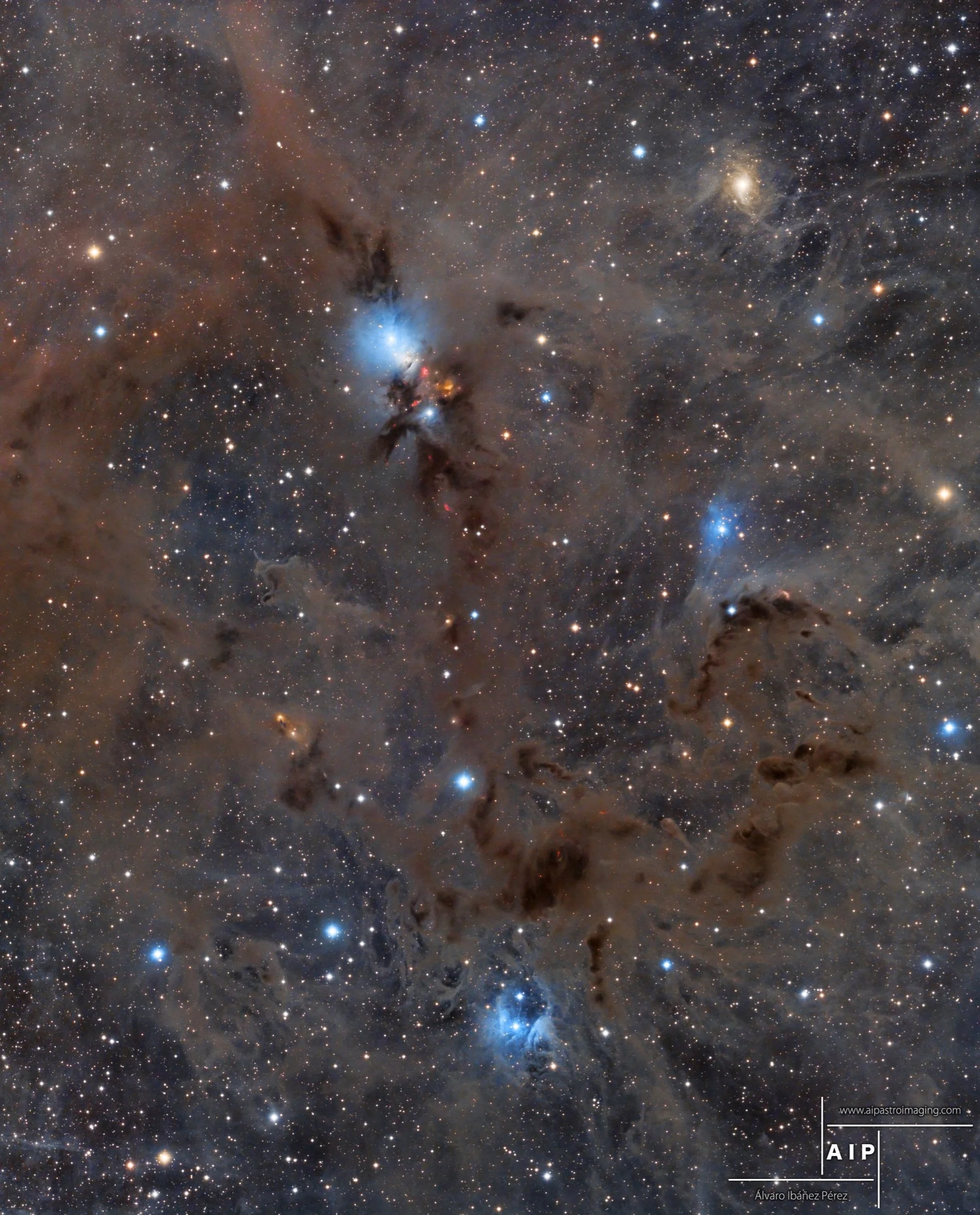
AAPOD2 Image Archives
NGC 1333, Barnard 203, Barnard 204: A dusty view of Perseus
Deep in the constellation Perseus, a cosmic tableau unfolds, featuring the star-forming region NGC 1333 and the dark nebulae Barnard 203 and Barnard 204. This stunning view is dominated by rich, dusty filaments that weave through the scene, creating a stark contrast against the faint glow of scattered starlight.
NGC 1333, nestled to the left, teems with youthful stars hidden within veils of gas and dust, their energetic outflows sculpting the surrounding material. Meanwhile, Barnard 203 and 204 cast inky shadows across the image, standing as quiet sentinels in this dynamic environment.
Together, these structures offer a breathtaking glimpse into the interplay of light and shadow, showcasing the raw materials of star formation and the intricate beauty of the cosmos.
ngc 1333
In the serene realms of the Perseus constellation, NGC 1333 emerges as a stellar masterpiece, a reflection nebula adorned with the cosmic glow of youthful stars. This celestial oasis, situated within the Perseus Molecular Cloud, serves as a stellar nursery, where the interstellar medium births new generations of luminous orbs. Approximately 1,000 light-years from Earth, NGC 1333 captivates with its ethereal hues and intricate structures, crafted by the interplay of starlight and surrounding dust. This cosmic portrait not only illuminates the beauty of NGC 1333 but also invites contemplation of the ongoing celestial ballet, where the cosmic dance of creation unfolds in the heart of the Perseus constellation.
NGC1333
Image Description and Details :
Telescope: Takahashi FSQ106EDX (f/5)
Munt: Takahashi EM400 Temma2
Camera: Atik 16200 mono
Filters: Astrodon Gen2 LRGB I-Series 50,8mm + IDAS LPS
Filter Wheel: SX USB Filter Wheel 5x50,8mm
Guider: Lunático EZG-60 + SXLodestar
Flat panel: RB Focus eXcalibur
Powerbox: RB Focus Balinor Pro
Focus: RoboFocus
Adquisition: N.I.N.A.
Processing: PixInsight Core + Photoshop
Exposure:
L: 90x600s bin1
RGB: 30x300s bin2 each channel
Total: 23h 30min
Captured during 4 nights from Yela, Las Inviernas and Navas de Estena (Spain)
Copyright: Alvaro Ibañez Perez
Stellar Nursery in Perseus
Our Milky Way is actually full of dust, but hidden in the black starry background, it is not easy to see. Only by accumulating a long time of exposure, the dust that pervades the stars will show up, presenting rich details of intricate complexity.
This large patch of dust in the picture is part of the Perseus molecular cloud, located at the junction of Taurus, Aries, and Perseus, about 1,000 light years away from the Earth. The dust with a total mass equivalent to 10,000 suns is gathered in clusters or twisted into twists. The thick areas are dense and opaque, and darker than space itself.
In this darkest corner, new light is gestating.
The dust near the center, a little red light came out from it, that was a star cluster forming in it. Beside this dust, a newborn star dispelled the haze, illuminating the surroundings with bright light, and became the brightest deep sky object in this area.
In the new Chinese year of the ox, may the world sweep away the dust, dispel darkness, and reappear light.
Location: Hebei Kangbao Galaxy Observatory
Filming time: November 7, 2020-February 4, 2021
Telescope: Sharpstar 150 2.8 HNT
Camera: QHY268C
Mount: Aton iOptron CEM70/CEM60
Guide : QHYCCD OAG-M
Guide camera: QHY5L-II-M
Number of shots: 130×1000 seconds, 70×300 seconds
Cumulative exposure: 41.9 hours
Shooting software: APT
Processing software: PixInsight, PhotoShop
Copyright: Steed Yu
NGC1333
Image Description and Details :
RECORDING DATA:Object: NGC 1333Date of recording: November 2020Distance: 1,000 light yearsExposure: 144 x 300 sec. (Total 12 hours)Calibration: Darks / Flats / DarkFlatsMount: Skywatcher EQ6-R PROTelescope: Lacerta Fotonewton 250/1000Corrector: Lacerta GPU coma correctorFilter: Astronomik L2 UV-IR Block 2 ″Camera: QHY268c @ Gain 0 at -15 ° CGuiding: ZWO OAG with ASI 120mm-s and PHD2Software: APP / Photoshop CC
Copyright: Daniel Nimmervoll
NGC 1333 Embryo Nebula
NGC 1333 Embryo Nebula in the constellation Perseus.
The NGC 1333 reflection nebula and its associated dark cloud L1450 (also known as Barnard 205) are located at the northern end of a degree-long, north-south ridge of CO emission in the Perseus region at the west side of a large cavity in the Perseus molecular cloud.
L-channel - 36 x 600 sec. bin 1x1;
R-channel - 25 x 600 sec. bin 1x1;
G-channel - 25 x 600 sec. bin 1x1;
B-channel - 25 x 600 sec. bin 1x1.
Total integration time - 18:30 hours.
My setup: Telescope 8" Celestron Schmidt-Cassegrain (SCT) CPC800 GPS (XLT) on the equatorial wedge, focal reducer Starizona 0.75x, Feq.= 1626mm, camera Starlight Xpress Trius SX694, SX mini filter wheel, filters Astrodon LRGB E-series gen.2 .
Capture and processing software: MaxIm DL6, PHD2, PixInsight, StarTools, Photoshop CC, Zoner photo studio 14.
North at the top.
Copyright: Boris Vladimirovich







